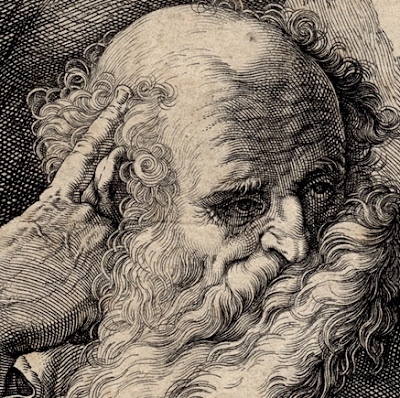Hendrick
Goltzius (aka Hendrik Goltzius) (1558–1617)
”St Andrew", 1589, plate 2 from the series of fourteen small engravings:
“Christ, The Twelve Apostles and St. Paul.”
Engraving on fine laid paper lined onto a support sheet.
Size: (sheet) 14.5 x 10.3 cm; (image borderline) 12.2 x 10 cm
Inscribed al lower left within the image borderline with the
artist’s monogram of entwined initials: “HG.”
Numbered below the image borderline at centre: “II.”
Lettered in three lines of Latin below the image borderline:
"Et in Iesvm Chrtvm / filivm eivs vnicvm, Domin- / vm nostrum"
State iii (of vi). Note state iii has an inscribed “second” number
at the lower left corner. This print is trimmed within the platemark at the
lower edge and thus the critical feature is missing that would help to certify
that it is from state iii. Nevertheless, this impression is not from states i
or ii as these earlier states differ in the lettered text—state i has no text
and state ii is not inscribed with the number “II”—nor is the impression from states
iv, v and vi as TIB (supplement) advises somewhat curiously that “no impression
is found to correspond” with state iv and states v and vi show variations to
publication details concerning “F. de Wit.”
The British Museum offers the following description of this print
from the third state:
“Plate 2: St Andrew. Half-length, heavily bearded and resting his
hand on a book, a crucifix at left; third state with double numbers. 1589” (http://www.britishmuseum.org/research/collection_online/collection_object_details.aspx?objectId=3036306&partId=1&searchText=goltzius+Andrew&page=1)
TIB 3 (3). 45 (24) (Walter L Strauss 1980, "The Illustrated
Bartsch", vol. 3, p.51); New Hollstein (Dutch & Flemish) 22 (Hendrick
Goltzius) Bartsch III.24.45; Hirschmann 1921 36 (Otto Hirschmann 1921, “Hendrik
Goltzius, Verzeichnis des graphischen Werkes”, Leipzig); New Hollstein (Dutch
& Flemish) 36 (Hendrick Goltzius) (F W H Hollstein 1993, “The New
Hollstein: Dutch and Flemish etchings, engravings and woodcuts 1450-1700”,
Amsterdam)
Condition: marvellously crisp and well-printed impression trimmed
along the platemark on the top and sides and slightly within the platemark at
the lower edge. The sheet has closed tears at the upper and lower edges and
has been laid upon a support sheet of fine washi paper.
I am selling this rare and exceptional engraving by the legendary
Goltzius for the total cost of AU$366 (currently US$284.76/EUR241.42/GBP215.90 at
the time of this listing) including postage and handling to anywhere in the
world.
If you are interested in purchasing this superb print exemplifying
the sublime skills and mannerist leanings of Goltzius, please contact me
(oz_jim@printsandprinciples.com) and I will send you a PayPal invoice to make
the payment easy.
This print has been sold
Rather than discussing the importance of Goltzius’ contribution to
the art of engraving in terms of his famous “dot and lozenge” technique for
rendering gradations of tone and his amazing use of swelling line to describe a
subject’s contours, I thought I would address a very different topic: Goltzius’
use of body language.
When I look at the way that St Andrew rests his index finger on
his head I recall reading that this gesture signifies (at a subliminal level) that the subject is in deep thought. The finger position resting on the
head however needs to be pointing towards the brain for such a meaning to be understood
unambiguously. I mention the finger’s position because meanings change as the
finger progresses in its position down the side of the face to finally
signify absolute disinterest when the finger rests on the chin.
I also wish to draw attention to how Goltzius has used St Andrew’s
left arm as if it were a shield to protect the saint from the outside world. I
may be wrong in my interpretation of the saint’s body language in terms of the
arm keeping the world away from him but when seen in context with the way that
St Andrew seems to be burying his head into his beard I see a body language of
interpersonal barriers being erected.
At this point I should mention how the portrayed body language
works in context with the St Andrew’s cross in the sense of real and
psychological barriers but I will hold myself back from going further in case I
am alone in my reading of this image.








No comments:
Post a Comment
Please let me know your thoughts, advice about inaccuracies (including typos) and additional information that you would like to add to any post.